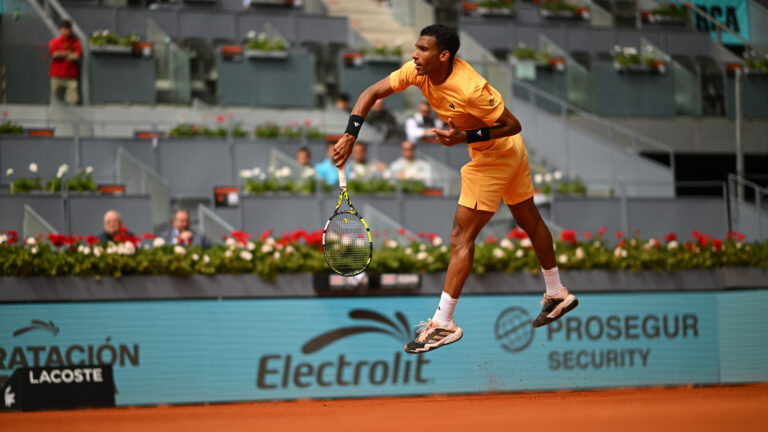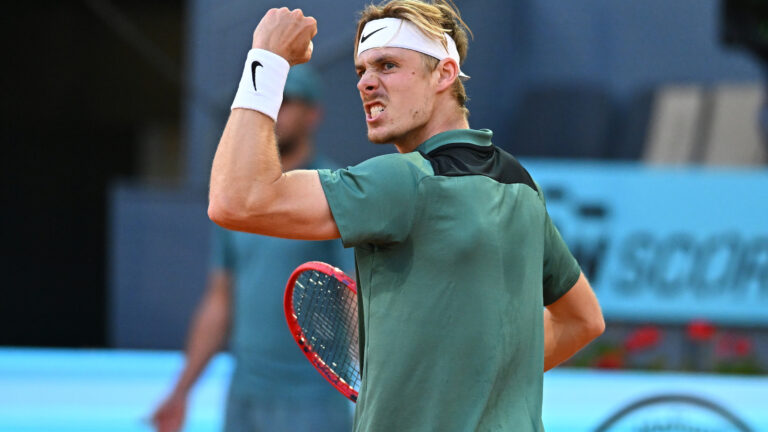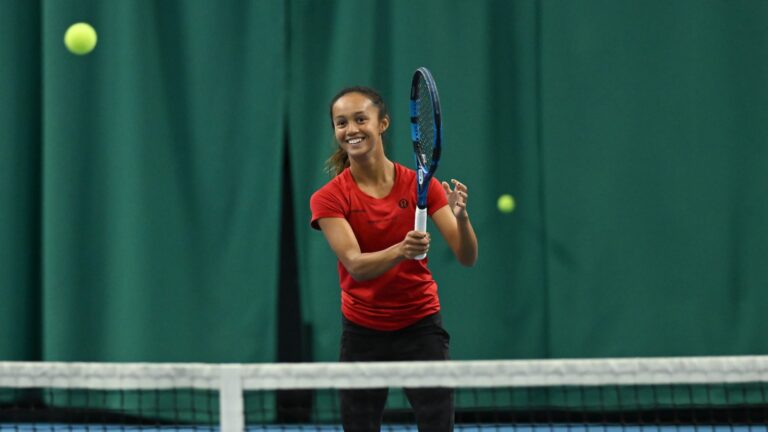TEBBUTT: MARIA, RAFA ENCORE IN PARIS

Mauricio Paiz
But for Serena Williams beating Maria Sharapova in the 2013 French Open final, it would have been a joint three-peat of the women’s and men’s titles for the highly-recognizable Russian and Rafael Nadal after they won together in 2012 and again this year. Of course Nadal also triumphed in 2013, something that has become as familiar a part of the Parisian spring as a sidewalk café waiters lording it over a North American tourists.
After 12 years without one that had gone to three sets, this year’s women’s final was more compelling than the men’s with Sharapova winning a thriller – 6-4, 6-7(5), 6-4 over the gritty Simona Halep – in three hours and two minutes.

Mauricio Paiz
There was an element of inevitability about Nadal’s 3-6, 7-5, 6-2, 6-4 win over Novak Djokovic. Three factors came into play:
1. Djokovic hinted in his media conference after a struggle to beat Ernests Gulbis in four sets in the semi-finals that he was not right. It turns now that he may have had some sort of stomach bug that was also bothering him during the final.
2. After 12 days of dull, coolish weather, the temperature rose to close to the 28-degree range for the final three humid days. It’s widely known those are the conditions that Majorcan Nadal prefers and that don’t suite Djokovic, who has been known to have breathing problems.
3. Nadal was lights-out in a 6-3, 6-2, 6-1 clobbering of Andy Murray in the semi-finals, indicating that any earlier concerns about his back were no longer relevant and that he was close his having his usual Rafa-like Roland Garros gusto.
Djokovic would later admit that he had a serious physical and emotional letdown after losing the second set and that gave Nadal, whip-lashing his warrior forehand, a chance to gain the ascendancy.
When the Spaniard broke serve and led 4-2 in the fourth set, it appeared that Djokovic was “cuit” (cooked as the French say) but he summoned a final effort – with shade finally covering the court and the heat somewhat subsided – and got back to 4-all.

Mauricio Paiz
Serving at 4-5, he led 30-love and it appeared things might get very interesting as they had been in his two previous matches with Nadal at Roland Garros – a two-day ordeal in the 2012 final and a 9-7 in the fifth set marathon in the 2013 semi-finals.
At 30-15, Djokovic whacked a decent approach shot down-the-line to Nadal’s backhand and went to the net. Probably a reasonable move against any other player, but Nadal speeded over and replied with a dart backhand cross-court passing shot that Djokovic was nowhere near.
Two points later, with two fans interrupting him as he tried to make his toss on a second serve at championship point, he double-faulted the ultimate point – as he had in the 2012 final.
It was later learned that Nadal was cramping and could have been vulnerable in a fifth set and Djokovic seemed to be reviving as the conditions became less severe with the cloud cover.

Mauricio Paiz
The loss was a crushing disappointment for Djokovic, losing for the third year in a row to Nadal as he tried to win the one Grand Slam missing from his record.
He was still pretty down during his media conference, which is rare for the good-natured, easy-going Serb. He did not, clearly, want to reply to a question I asked him – probably because it would have sounded like he was making an excuse.
Here’s that exchange:
Q.This is a hypothetical question: if the match started at 6:00 with no sun and a cooler temperature, do you think things might have been different?
NOVAK DJOKOVIC: Well, if I was left hander maybe I would win the tournament. (Laughter) I don’t know. I don’t know how to answer that question.”
I have written many times that Djokovic’s 2011 is the best year I have ever witnessed in men’s tennis: he won three of the four Grand Slams, lost only one completed match (Roger Federer in the French Open semi-finals to end his 41-match winning streak) until after the US Open and, key in this argument, overtook two of the greatest players of all-time – going 6-0 with Nadal and 4-1 with Federer for the year.
What’s shocking based on that incredible year, since winning the Australian Open at the start of the following year in 2012, he has played nine Grand Slams and won only the 2013 Australian Open – losing the five other Grand Slam finals he has played in over that period.
This year he brought in Boris Becker to potentially help give him a psychological lift in those critical matches. That has clearly not yet produced results but, to be fair, there are many uncontrollable variables at tournaments – the draw, weather, upsets, injuries, match-ups – that can come into play. Who saw Stan Wawrinka or Serena Williams, Li Na and Agnieszka Radwanska going out so early in Paris this year?
Djokovic fans have to hope that he will not be discouraged. He has come too close too many times to not have the odds start working in his favour. A victory at Wimbledon and/or the US Open would go a long way restoring some justice related to his fate at recent Grand Slam events.

Mauricio Paiz
As for Nadal, he is the absolute and ultimate beast at Roland Garros. As unlikely as it might seem – if he had not been distracted by his parents’ (temporary) separation and a knee problem (which subsequently kept him out of Wimbledon), he surely would have beaten Robin Sodering in the 2009 round-of-16 and gone on to win the title that year.
Ten years in a row would have been phenomenal – and his dominance is no more obvious than in his career 66-1 record at Roland Garros. Here’s another hypothetical: if he hadn’t overdone it and incurred a stress fracture in his foot playing Richard Gasquet several weeks before the 2004 French Open and been unable to play it when he was about to turn 18, maybe he wins that year and is now in double figures.
Nadal mentioned after his win on Sunday that the Roland Garros victory helps make up for him losing the Australian Open final in January when he was diminished by a back problem against an opponent (Wawrinka) whom he had beaten in all 12 of their previous meetings.

Mauricio Paiz
Sharapova was 3-0 vs. Halep entering their final on Saturday, and there were fears that she would overpower the inexperienced Romanian the way she had in the last two sets of her 1-6, 6-2, 6-3 victory in the Madrid final in May.
There were periods in Saturday’s match when her big hitting – heavy forehands and laser-precise backhands – overwhelmed Halep. But the 22-year-old, now ranked No. 3, was spirited in responding. She upped the tempo on her forehand in the second set and was rewarded by wearing down the angular, less-mobile Sharapova, finally winning the tiebreak from a 5-3 deficit.
Who knows what would have happened if Sharapova had not taken an eight-minute bathroom break at that point to recompose and reinvigorate? Even as it was, Halep had a point for a 3-1 lead in the third set with Sharapova looking pretty gassed on a hot, sunny afternoon.
At the very end – 4-all in the third – Sharapova just had too much game and too much willpower, winning the last eight points to sew up her fifth Grand Slam title.

Mauricio Paiz
By her ecstatic reaction, and from what she said afterward, winning Grand Slams means much more to her at age 27 than it did earlier in her career.
It is to her credit that she signed on a new coach this year – Sven Groeneveld (below), who has worked with Mary Pierce, Ana Ivanovic and Caroline Wozniacki among others – and made a successful run at a major.

Mauricio Paiz
Sharapova’s shoulder surgery in 2008 was a major intervention and alteration to that joint. It probably can’t be understated how hard she has had to work to get the shoulder into serviceable order. Those fairly frequent, and often flagrant, double faults, often seem totally out of her control. But she does a tremendous job of persevering despite the frustration she must feel.

No doubt Serena Williams going out in the second round to Garbine Muguruza, opened the path for Sharapova this year – they were slated to meet in the quarters. But she had to win her way to the title against some stiff opposition, including an aggressive Muguruza in the quarter-finals and a fearless Eugenie Bouchard in the semi-finals, and all with the expectation and pressure on her after Williams was ousted. Maybe her performance can best be summed up by what some guy in the crowd kept calling out during Saturday’s final, “Ave Maria.”
EUGENIE AND MILOS

With 20-year-old Eugenie Bouchard now ranked No. 12 in the WTA rankings, and 23-year-old Milos Raonic at No. 9 in the ATP rankings, Canada has the two best prospects at the elite level of the men’s and women’s games.
Both were impressive heading into Roland Garros – Bouchard winning her first title in Nuremberg the previous week, and two weeks earlier Raonic going all the way to the Italian Open semi-finals before putting up stellar opposition to Novak Djokovic.
In Paris, Bouchard won five matches, including outplaying No. 8 seed Angelique Kerber 6-1, 6-2 in the quarter-finals, before giving Maria Sharapova a genuine scare (4-6, 7-5, 6-2) in the semi-finals.

Raonic reached his first Grand Slam quarter-final, overcame the tenacious clay-courter Gilles Simon in five sets in front of a partisan French crowd and gave Djokovic some anxious moments in a 7-5, 7-6(5), 6-4 quarter-final loss.
Bouchard has continued a steady progression since making the semi-finals of the Australian Open in January while Raonic has unquestionably upped his level the past couple of months – playing closer to the baseline, hitting bigger and overall exhibiting a confidence in his abilities that had not been there before.
Both have skills that should translate well to grass leading into Wimbledon and at Wimbledon, but they will also now be targets because of their recent success.
While not in the top three or four players who will be on the bookmakers’ lists favourites for London SW19, they won’t be far off and will definitely be fun to follow.
THE PIC AND THE STORY

Mauricio Paiz
Even a player as good as Milos Raonic will sometimes get caught out of position – that happened in his quarter-final match against Novak Djokovic and photographer Mauricio Paiz caught it at just the right moment. Below is Raonic’s media-conference explanation of what happened.
Q. The first point of the third set when you sort of got jammed by a ball that he got by you and you missed it, you were on the baseline, left-hand corner, were you just trying to get around it? It kind of surprised you or took a funny bounce?
MILOS RAONIC: I tried getting around it – didn’t get around quickly enough. I thought he wouldn’t have gone as aggressively with a backhand.
ROLAND GARROS SOUVENIR

There are moments that remain with you at the end of a Grand Slam tournament. At the French Open this year, there were footprints with the Roland Garros logo on them stuck on the sidewalk to show the route to the site.
One evening walking home, there was a young couple near me and the woman reached down and unstuck one of the gooey footprints to keep as a souvenir.
It had been well trod on and was sticky, but that she would want it as a souvenir showed just how much the event meant to her.
THE LUCK OF THE LENS

On one of the earlier days of the tournament, I took some pictures of the video screens outside the Court Suzanne Lenglen – the sculpture of the legendary Frenchwoman is in the background here – and didn’t notice until just recently that Robin Haase of the Netherlands is in the shot with his racquet bag over his shoulder.
Haase, after his upset of Richard Gasquet on Tuesday, is a possible quarter-final opponent for Milos Raonic at this week’s grass-court tournament in Halle, Germany.
PARIS POST CARD

Except for the Eiffel Tower, it doesn’t get much more picture post-card in Paris than the view up the Champs Elysées toward the Arc de Triomphe. The British and French flags hanging together were part of last weekend’s 70th anniversary of D-Day celebrations.


